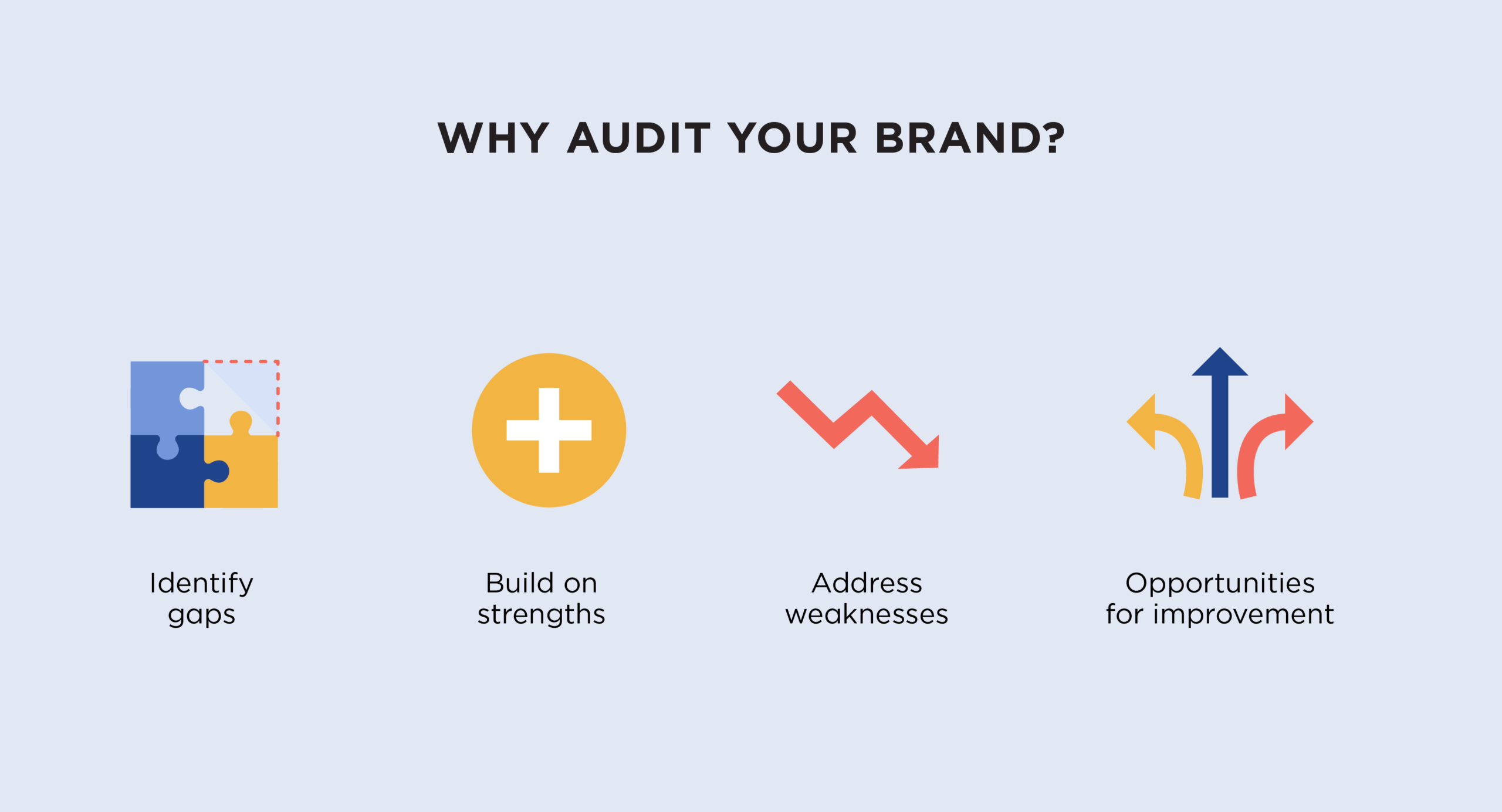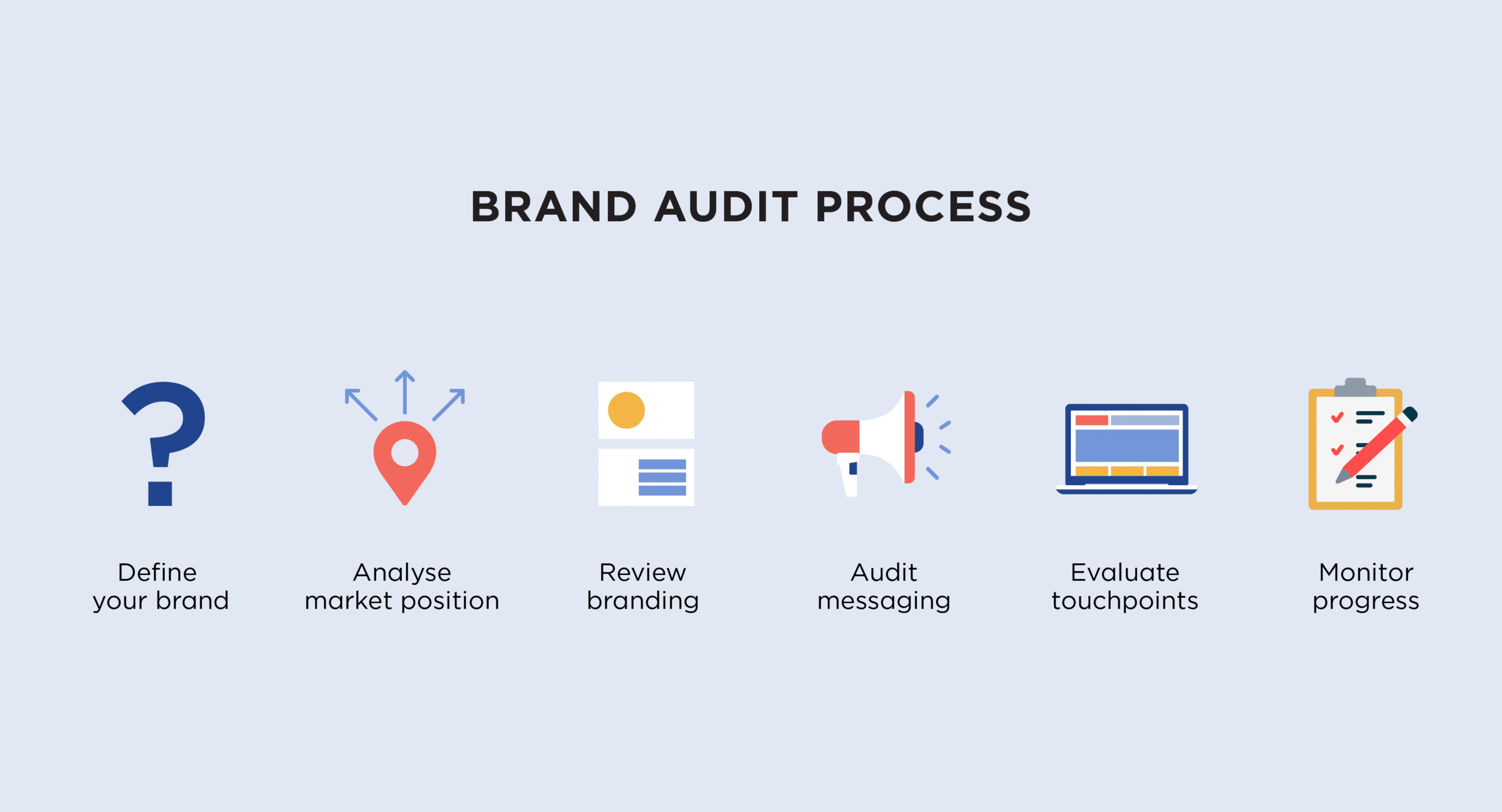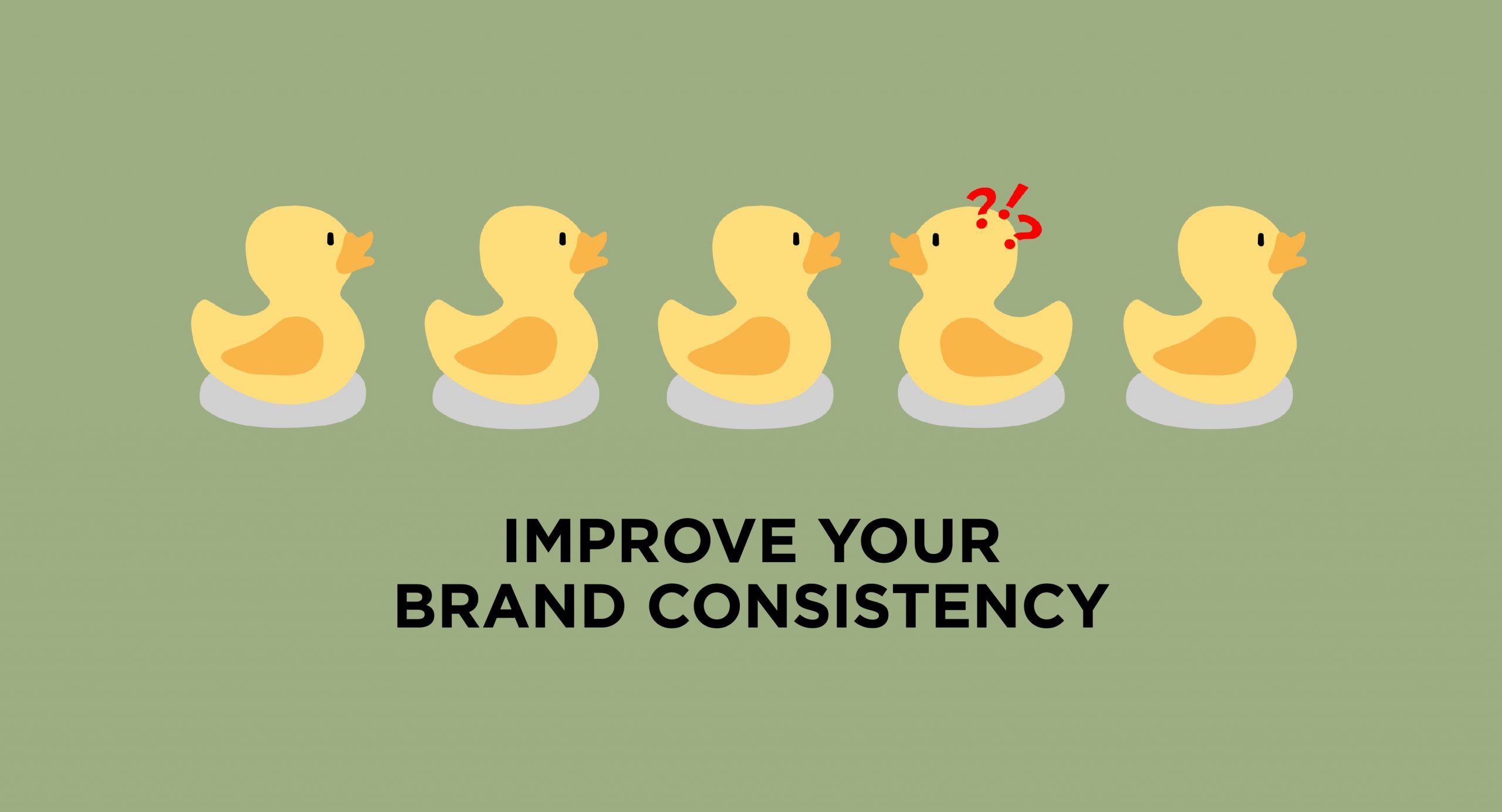BRANDING
How To Conduct A Brand Audit: A Step-By-Step Guide
To do a brand audit, you need to define your brand, analyse your market position, review your visual identity and messaging, evaluate your brand’s touchpoints and make an action plan. Brand audit checklists, templates and tools can help.
That sounds like a lot. But in this step-by-step guide, we’ll help you through the process and share expert tips to make it easier. Let’s begin by explaining brand audits and why you need to do one.
What is a brand audit?
A brand audit is an evaluation of your branding efforts to identify gaps, strengths, weaknesses, and opportunities for improvement. It helps to ensure your branding aligns with your goals and resonates with your audience.
Regular brand audits are essential for companies that want to build a solid and successful brand.
Our brand audit process systematically examines brand identity, market position, visual identity, messaging, and touchpoints. Following this approach will help you conduct a comprehensive brand audit to get valuable insights into your branding efforts.

When should you do a brand audit?
Here are seven situations when a brand audit might be needed:
- If you feel your brand no longer represents your business
- To help you decide if your brand needs a minor refresh or a complete overhaul
- If you are expanding your products or services
- If you are making a geographic move
- If you are undergoing a merger or acquisition
- If your sales have dropped off or your marketing isn’t achieving results
- If your brand developed organically without a strategy behind it
Brand audit process
Here are the steps you can take to audit your brand:
- Define your brand
- Analyse your brand’s market position
- Review your brand’s visual identity
- Audit your brand’s messaging
- Evaluate your brand’s touchpoints
- Make an action plan and monitor progress

1. Define your brand
The first step in conducting a brand audit is to define your brand. This step comprehensively examines your brand identity, vision, mission, values, and personality to ensure your branding efforts are delivered consistently, align with your business goals, resonate with your target audience and build customer loyalty.
A. Clarify your mission and vision
Your mission and vision should drive all that you do. Your mission is your purpose. It’s a statement about what you want to achieve. The vision is the future goal. Think of it like a road map to achieve your mission. Defining your mission and vision will take some deep thinking and time, but it’s highly worthwhile because it sets the tone for your entire business.
B. Document your brand identity
Your brand identity incorporates your brand name, logo, slogan, other visual components and the tone of voice of your written content. Your brand identity must be appealing to your customers. It also must be presented consistently across all platforms, like your website, social media profiles, ads and stationery. It’s useful to document your brand identity in a brand guidelines document so all brand materials can be created with the same consistent identity.
C. Detail your brand values
Your brand values are what your company stands for. They address the convictions and rules that guide your brand’s behaviour. Defining your values and ensuring they flow through every part of your business is essential to build customer trust and brand loyalty.
D. Assign your brand personality
Brand personality is the human attributes and characteristics that address the brand’s image and voice. You should always ensure every customer touchpoint is delivered with your defined brand personality in mind.

2. Analyse your brand’s market position
The second step in conducting a brand audit is to analyse your brand’s position in the market. This step involves comprehensively examining your brand’s competitive landscape, along with a SWOT analysis and consumer research. This step will help you better understand your brand’s market position, identify areas for improvement and develop a more effective marketing strategy.
A. Conduct competitive analysis
Conducting a competitive analysis helps you understand your competition’s strengths and weaknesses compared with your own. With this information, you can identify the gaps in the market and find out where you can place your brand compared to theirs.
Look at their brand positioning, product range, pricing, distribution channels, target audience, messaging and marketing tactics as a starting point.
B. Undertake a SWOT Analysis
A SWOT analysis helps to identify your brand’s internal strengths and weaknesses, along with the opportunities and threats in the external environment. Conducting a SWOT analysis is a structured way to help you better understand your brand’s market position and identify opportunities for improvement.
C. Perform consumer research
Doing consumer research helps you understand your ideal audience’s needs and preferences. The more you know about who they are, how they think and what they’re looking for in a company, service or product, the more you can communicate effectively with them.
Check your online reviews, do a poll on social media or set up interviews with your customers and ask in-depth questions. It will help you identify opportunities to create an effective marketing strategy or improve your existing one.
3. Review your brand’s visual identity
The third step in conducting a brand audit is to review your brand’s visual identity. This step thoroughly examines your brand’s logo and tagline, colour palette, typography, brand imagery and photography. Reviewing your brand’s visual identity ensures that your branding efforts are consistent, memorable and reflect your brand’s values and personality. This can help build brand recognition and loyalty and drive business growth.
A. Analyse your logo and tagline
Your brand’s logo and tagline are your visual identity’s most prominent and recognisable elements. Take time to assess if they are simple, memorable, reflect your brand’s values and personality, and appeal to your customers. Ask staff and customers for feedback and be prepared to update them if they’re no longer doing the job.
B. Scrutinise your colour palette and typography
Your brand’s colour palette and typography are crucial in creating a consistent and recognisable brand image. Therefore, it is essential to ensure they are consistent across all touchpoints and reflect your brand’s values and personality.
C. Review your brand imagery and photography
Once again, your brand’s imagery and photography should reflect your brand’s values and personality and resonate with your target audience. Spend some time checking that your imagery and photography are consistent and appealing because if they aren’t, it can hinder the success of your business.
4. Document your brand’s messaging
The fourth step in conducting a brand audit is to define your brand’s messaging. This step involves a comprehensive examination of your customer’s needs to ensure what you say and how you say it appeals to your target audience and effectively communicates your brand’s key benefits.
A. Examine brand messaging and tone of voice
Review your current marketing materials to analyse how you talk about your brand. Your brand’s messaging and tone of voice should be consistent across all touchpoints and reflect your brand’s values and personality.
B. Define brand messaging and tone of voice
Document the key messages of the brand to ensure that you are always talking about the brand and the products and services in the same way. Make sure your communications are consistent with the brand by linking your tone of voice to the personality and values.
5. Evaluate your brand’s touchpoints
The fifth step in conducting a brand audit is to evaluate your brand’s touchpoints to see if they are consistent, well-designed, and uphold your brand identity. You need to examine every contact point where your customer might interact with your brand, like your website, social media accounts and marketing, as well as the customer experience, your physical store or offices and customer service channels.
By evaluating your brand’s touchpoints, you can identify areas for improvement and ensure that your branding efforts effectively build brand recognition, loyalty, and advocacy to drive business growth.
A. Review website content
Your website is often the first touchpoint for potential customers, and making a good impression is essential. First, check that your content is well-organised, easy to navigate and optimised for search engines. Then, make sure your website clearly communicates how you will help customers.
Ensure your messaging is consistent and quickly gives people the information they need. Try to ensure you’ve demonstrated that you understand precisely what they need and show them how your product or service delivers.
B. Investigate social media content and engagement
Your social media presence is crucial in building brand awareness, engagement, and loyalty. Check that you are posting information and imagery on your social media that’s engaging, informative and reflects the business’ personality, messaging and vision. Ensure you engage with your followers promptly and authentically in the brand’s tone of voice.
C. Evaluate your marketing efforts
In addition to your website and social media, you need to analyse all other marketing for consistent branding. Look at emails and newsletters, advertising, events, sponsorship, and public relations activities and see if there are opportunities for improvement.
D. Study your customer journey
Your customers’ experience with your brand can significantly impact their brand perception and their likelihood of becoming repeat customers or advocates. Therefore, you must ensure that your customer journey is well-designed, easy to navigate and a positive experience.
It’s also important that your brand’s values and personality are consistently delivered throughout. Customers will go elsewhere if your in-store service doesn’t live up to your website’s friendly and welcoming tone.
6. Make an action plan and monitor progress
The sixth and final step in conducting your brand audit is to create an action plan. It should identify all the areas for improvement that you uncovered in your audit. Ensure you prioritise your action plan and allocate the right resources to get it done. Hire expert help if you need it. Monitor your progress to see if your changes help you achieve your goals.
Brand audit checklist and template
A brand audit checklist and template can help ensure your brand audit is comprehensive, thorough, and effective.
A. Importance of having a brand audit checklist
A brand audit checklist can help you stay organised and cover all the necessary components of a brand audit. It can also help you identify improvement areas and develop actionable insights to improve your branding efforts.
B. Examples of brand audit templates
Many brand audit templates are available online, and you can choose one that best fits your specific needs and objectives. Some examples of brand audit templates include a SWOT analysis template, a brand identity audit template, and a customer experience audit template.
When selecting a brand audit template, it’s essential to ensure that it covers all the components of a comprehensive brand audit.
Auditing your brand is crucial in building a solid and recognisable brand. By following the five steps outlined in this post and using a brand audit checklist and template, you can ensure that your branding efforts effectively communicate your brand’s values and personality and drive business growth.
Brand audit tools
Conducting a brand audit can be complex and time-consuming, but many tools are available to help make the process easier and more efficient. Here are three tools that can be especially helpful in conducting a brand audit:
A. Brand audit software
There are many different tasks to complete for your brand audit. One of the best ways to ensure you don’t miss any necessary steps is to set up a project in a task management app. Examples of task management software that you could use to manage your branding audit project are Monday, Asana and Trello.
B. Analytics and data visualisation tools
Analytics and data visualisation tools can help you to track and analyse your brand’s performance metrics, including website traffic, social media engagement, and customer satisfaction. In addition, these tools can help you identify improvement areas and develop actionable insights to improve your branding efforts. Examples of analytics and data visualisation tools include Google Analytics, SEMrush, and Tableau.
C. Survey and feedback tools
Survey and feedback tools can gather feedback from customers and stakeholders about their perceptions of your brand. These tools can help you identify improvement areas and understand how your brand is perceived in the marketplace. Examples of survey and feedback tools include SurveyMonkey, Typeform, and Qualtrics.
Ready to tackle your brand audit?
A brand audit is essential for any business looking for ways to improve its results. By following our step-by-step process, you can ensure that your branding efforts effectively communicate your brand’s values and personality, differentiate your brand from competitors, and drive business growth.
Remember, brands evolve over time, so a brand audit isn’t a set and forget task. A successful brand requires ongoing effort and attention, so you may need to revisit and refine your branding as your business evolves.
If you’d prefer to use a branding expert to complete your brand audit, please reach out for a free introductory chat.













